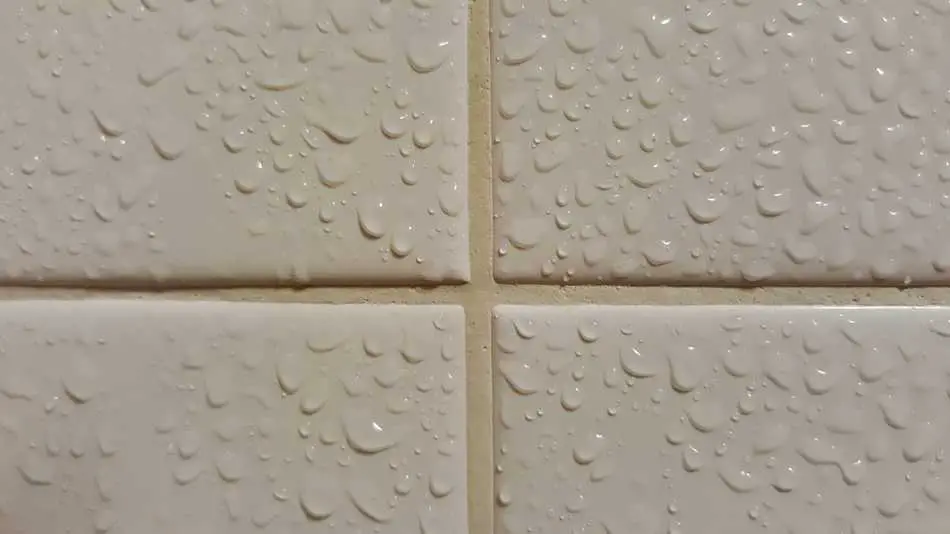You may have noticed when you were in the shower, or perhaps while you were cleaning. When your grout changes color after it gets wet, you might be concerned or at least confused. The good news is that, for some grout, this is a normal effect, and it should go back to the previous color once it dries again. On the other hand, if your grout was sealed, especially if you paid a contractor to do the job, then you have a problem. While some lightening is normal as grout cures, once it’s sealed in, your grout should not change color anymore. If it does, then you have a leak. When it’s only one or two small spots, then it’s likely accidental. However, if all the grout changes, then it’s likely that none of it has been sealed. I’ve grouted my share of bathrooms over the years, and I’m happy to share what I’ve learned about grout work and some of the unique challenges it can present.
Why does my grout change color when wet? Unsealed grout changes color when it’s wet because moisture is seeping in. Just as your hair or a towel looks a couple of shades darker when damp, grout also changes when moist. This is normal. However, if your grout was sealed, it shouldn’t change color once the grout and sealant have set. If it does, then the sealant didn’t do its job properly, and you may need to reapply it.
Why Does My Grout Change Color When Wet
Dampness changes the color of your wet grout just as it changes the color of most other things. This is a normal visual indicator of moisture and often more obvious on darker colored grout. However, if you sealed the grout, it should be water and stain-proof.
Older sealant needs to be reapplied annually, or more often if you scrub it frequently. The seal isn’t permanent and will come off or lose its effectiveness over time. Fortunately, it is simple to apply a new coat of sealant.
I recommend AQUA-X Grout Sealer from Amazon. This sprayable sealer offers a high-quality moisture barrier, which improves the appearance and durability of your grout. Better still it has no unpleasant odor and is very low on VOCs. Plus you can easily reapply and even rinse dirt right off the grout once it’s fully sealed. Learn more by clicking here.
Take the time to fully scrub and dry your grout before applying a new sealant to avoid trapping dirt and moisture inside. Then you can spray on or paint on a layer of grout sealant. You may want to dry the first layer and then add a second coat to ensure you get a good moisture seal. Otherwise, follow the directions on your grout sealant container and enjoy non-color-changing grout.
When To Worry About Grout Changing Color
Stained grout can look ugly. Especially when your grout is white or very pale, it shows minerals, dirt, and even rust very easily. A high-quality grout sealant will prevent this issue. However, most stains are nothing to worry about since they are essentially harmless.
If the stains bother you, then I recommend a deep cleaning. Most of the time, a sturdy scrub brush and the right cleaner are all you need to eliminate the stubborn discoloration. With a little elbow grease and patience, they should come right off.
For cleaner grout all the time use Grout-EEZ Super Heavy-Duty Tile & Grout Cleaner. The included brush can get the deep-set stains out with ease. Furthermore, this made in the USA product is professional-grade and does a wonderful job. Plus, you can feel good about having Grout-EEZ in your cleaning supplies because it helps provide local jobs for people here in the United States. See the Amazon reviews when you click here.
When you notice black or grey moldy stains, you should be concerned. Mold spores spread easily, and some varieties can make you quite ill. Clean these up with bleach, and if they are persistent or return often you should replace the grout. After that make sure to clean more often with bleach, and always ventilate well when using chemicals.
In really severe cases, you may need to sand or replace your grout. Fortunately, grout is also an easy enough job to accomplish with little experience. Make sure you pay close attention to the mixing instructions and wipe away excess from the surrounding tile before it dries and sets for a clean, professional look.
Let the new grout cure for twenty-four to forty-eight hours, or per the instructions. You may need to sand it down a bit to get a finished look, but after that, apply a sealant as described above to keep the grout from changing color in the future.
Grout Changes Color As it Sets
While it’s normal for wet, unsealed grout to change color, there’s another grout color change that many first time DIYers are surprised by as well. Mixed grout is, by its very nature, also damp or wet. As a result, the color that it dries to is not the same as the color it appears when you first apply it. This can be problematic if you are trying for a perfect color match in your bathroom or kitchen.
If you want to know your grout’s dry-color before you tile a whole area, then I suggest testing it. Take a small bit of grout and place it on a neutral color background or a piece of spare tile. A spot roughly the size of a pea is enough to get a fair idea of the color, and it shouldn’t take too long to dry. Follow the direction on your particular grout to let it cure completely.
After a day or two, your grout will be fully dry, and you can see the finished color. At this point, you may also opt to put a layer or two of sealant over your grout. Some sealants have a shine to them after they have dried, leaving a sealed grout looking wet all the time. If you are particular about the finished look of your grout, then it’s worth the extra time. Try starting with a slightly darker looking wet grout to get a closer color to the one you want.
Additionally, you can follow the advice of the Washington Post, which says to mix your grout with pure water and no additives. This will come closest to having a final color that is the same as the color it is when you pull the unmixed powder from the bag.
For a lovely custom color that doesn’t stain easily try Simple Premium Grout in Delorean Gray from Amazon. This pre-mixed grout is already colored and will set off any installation with class. Furthermore, this grout is also temperature resistant, plus crack and shrink resistant. You’ll appreciate the quality of this reliable brand. Have a gallon tub delivered to your door when you click here.
What to Do If Your Grout is Too Wet or Too Dry
Applying grout that is too wet or too dry can affect how it seals and looks. You may get sub-par results when you fill those joints if you’re not careful to heed the instructions. Naturally, if this is your first time working with this unique substance, you cannot expect to have a feel for how it is supposed to look and work. Still, there are two straightforward ways to fix improper grout before putting it on your surfaces.
Wet, runny grout has too much water in it. If it doesn’t stay in place, you end up with gaps, and moisture will get in where you don’t want it. By slowly and carefully adding a little more grout powder and mixing as you go, you can adjust the consistency. Alternatively, too dry grout that flakes off or crumbles is far too dry. You resolve this issue by adding a few drops of water at a time until you reach the desired consistency. Remember that it is easier to fix the grout beforehand than remove and replace bad grout later.
Final Thoughts
If this is your first time noticing the color change in your grout, it’s normal to worry a bit. However, the problem is easily solved. Laying and sealing grout is no trouble at all, and though you need some patience and a steady hand, it’s an okay project for beginners.
When you replace grout, remember to wipe away the excess with a damp cloth before it dries. Doing this will prevent the grout from sticking to your tile and generally looking slapdash. Taking the time to get the right mix, clean up properly, and seal your grout is all it takes to have a spectacular, color-change free bathroom or kitchen.
Ensure you clean grout regularly and remove it if it’s flaking, broken, or turning colors even when it’s not wet. There’s no reason to leave a gross mess or rough edges and broken pieces lying around to make your home look bad.

